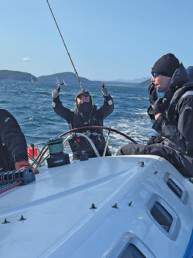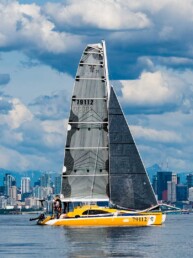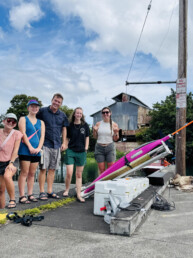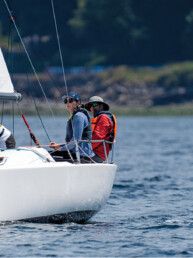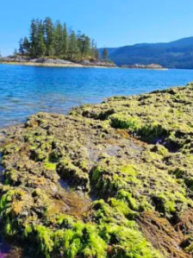Not your average race, R2AK has a habit of changing lives. As Team Bunny Whaler’s Nate Rooks explains, “I was different after R2AK. Not just the deep tiredness and missing 15 pounds, but a sense of inner peace I’d never experienced.”
The following article originally appeared in the June 2019 issue of 48° North.
You can’t just heave-to in a 17-foot dinghy. Certainly not in a full gale. So when my brother, Cooper, yelled “We need to reef again!” I prepared for another head-to-wind thrashing. We were roughly halfway up Grenville Channel, the 45-mile long, half-mile wide sliver just south of Prince Rupert. The mountains toppling down into the narrow waterway were breathtaking, but the 45-knot gusts screaming down the rock-lined waterway inspired a different kind of awe. We were unsettled by the fine mist blowing across the surface of the waves like snow swirling down a midwestern highway. Too scared to turn around and risk broaching, we tacked back and forth across the channel for four hours, making what progress we could. Each tack demanded more attention, speed, and coordination than I’d ever sailed with. Coop would yell, “Tacking in 10!… Tacking in 5…!” as I made sure I had the jib sheets clear and my feet perfectly aligned to step over the rowing station and get on the opposite rail as quickly and surely as possible. Howling gusts threatened to knock us over, nearly succeeding several times despite Coop’s efforts to sail on the edge of luffing. Yet even as we scanned the shore for bailouts, I had an underlying confidence that we would be ok. I was sailing with my brother, the most capable sailor I’d ever known, and we were aboard our beloved Bunny Whaler. We were unsinkable, after all. Seeing the Inside Passage with my brother had been a goal long before the Race to Alaska blew up the boating world. When I was 15, Coop spent his post-high school gap year building a stitch-and-glue kayak and paddling up the Inside Passage. Ever the emulating younger brother, from that point on, my big dream was for us to build rowboats together and explore the incredible waterway snaking its way from Washington to Alaska.
The next year, I followed in Coop’s footsteps and joined our fledgling local rowing club, a decision that ended up dictating the ensuing 15 years of my life – from unwitting high schooler to collegiate rower to collegiate rowing coach.
Rowing is a weird sport. You don’t need to have practiced since you were three years old to have success. You just have to be a certain size, with a certain kind of engine, and a tolerance for discomfort. I had been the biggest kid in the class for much of my life. Actually, before I was born they thought I was twins (I’m not kidding, you can ask my mom). Walking into icy water at 5am to launch boats and pulling on the oar until I threw up was brutally uncomfortable, but also intensely gratifying. I found myself recruited to row at Stanford University, where humbling lessons in hard work and honesty led to significant personal and athletic successes, including national championships. A previously discovered passion for coaching led me back to the Stanford Boathouse where I coached the women’s rowing team for seven rewarding years. I went all in, enjoying it more than I had liked rowing myself. I thought I would coach forever.
Meanwhile, Coop grabbed adventure opportunities, single-handing a Moore 24 around Puget Sound for a decade and delivering a 70-foot sailboat to New Zealand. But every year, Coop and I would talk about how someday we’d build the boats and do “The Trip.”
I had never expected to be away from my family’s home on Bainbridge Island for much longer than college, and constantly wondered when would it, could it, be a good time to return to my close-knit, adventure-loving family? At some point, I realized it wasn’t just going to happen on its own. As if to taunt me, there was talk coming out of Port Townsend about a new, oddball boat race, some seriously loony adventure stuff up the Inside Passage. They called it R2AK, and Coop and I couldn’t stop talking about it. I moved back to Bainbridge Island in the summer of 2015 and devoted a year to planning, preparing, and training for the Race to Alaska 2016. I didn’t know that doing so would become a seismic event in my life, shaking its way into every facet of my existence and leaving my personal landscape permanently altered.
I had returned to Washington delirious with self-determination and taking a deep breath of the winds of freedom; and thus had planned to take my time in finding the perfect Northwest girl. That plan lasted about three days once I became reacquainted with an old flame, Alex. She was another Bainbridge Islander, and our history, chemistry, and shared desire to chase adventure sent us quickly off the deep end of love. R2AK had drawn me home, and even before planning started in earnest, it was causing waves.
With nine toes over the edge and eager to see these R2AK lunatics in person, I attended the inaugural 2015 Blazer Party – a bacchanal that mocks the racers as much as celebrates them, held during the Port Townsend Wooden Boat Festival. I left the party thoroughly convinced that we must do the race. That weekend, Coop and I hopped in our uncle’s Boston Whaler Harpoon 5.2, an open, beamy daysailer. Most people, including the Boston Whaler reps at the Seattle Boat Show, have no idea that the company ever made sailboats. Yet from 1977-83, small runs of three stout Harpoon models were built with foam-filled hulls just like the legendary skiffs. Our mid-sized 5.2 was named Bunny Whaler, in honor of Bob Marley’s under-appreciated bandmate. After the Blazer Party, our test was to see if we could paddle it above two knots. After a few canoe-style strokes up Crystal Springs at a satisfactory 2.5 knots, we decided we’d rather have “The Unsinkable Legend” than a cabin. We imagined modifications like a beefy rowing system and an axe as a tiller would make it a reasonable boat to take up the Inside Passage without a motor.
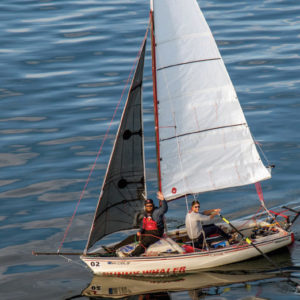 Well, not completely reasonable. As people found out about our plans, “you’re crazy” was a common refrain. Some boating mentors proffered their wisdom on how we could be smarter, starting with a different boat. We knew it seemed a bit outlandish, but our heroes had always been people like Robin Lee Graham, Bernard Moitessier, and Betty Lowman Carey – intrepid boat adventurers who would make you shake your head in disbelief and awe at their capability and self-reliance. We’d grown up spending entire weekends seeing how far we could go in a 13-foot Boston Whaler motorboat (once covering 180 miles around the Salish Sea in a single day). Most importantly, Bunny Whaler was the boat we had, and after years of fun sailing, we knew and loved her. So there wasn’t really any other choice. We disassembled the boat, built a sliding seat rowing system atop the centerboard trunk, reinforced the transom and rudder, and spent most of our budget on new sails: a triple-reefed, blue-water style mainsail; a jib with a fisherman’s reef; and an asymmetrical spinnaker off a carbon fiber bowsprit – normal dinghy stuff , right?
Well, not completely reasonable. As people found out about our plans, “you’re crazy” was a common refrain. Some boating mentors proffered their wisdom on how we could be smarter, starting with a different boat. We knew it seemed a bit outlandish, but our heroes had always been people like Robin Lee Graham, Bernard Moitessier, and Betty Lowman Carey – intrepid boat adventurers who would make you shake your head in disbelief and awe at their capability and self-reliance. We’d grown up spending entire weekends seeing how far we could go in a 13-foot Boston Whaler motorboat (once covering 180 miles around the Salish Sea in a single day). Most importantly, Bunny Whaler was the boat we had, and after years of fun sailing, we knew and loved her. So there wasn’t really any other choice. We disassembled the boat, built a sliding seat rowing system atop the centerboard trunk, reinforced the transom and rudder, and spent most of our budget on new sails: a triple-reefed, blue-water style mainsail; a jib with a fisherman’s reef; and an asymmetrical spinnaker off a carbon fiber bowsprit – normal dinghy stuff , right?
My brother has always been my boating hero. I have memories of him rowing me around in the San Juan Islands when I was just a toddler. He’s always seemed to know the answers to all of my boat questions, the design of every boat on the water, and possess the preternatural skill to operate boats with a calm and unwavering command. I knew I could make good choices on the water, but it was the years of relying on his mastery of all things boat-related which gave me confidence (if not hubris) that my modest experience sailing and cruising wouldn’t sink us. If Bunny could sink, of course.
When race day finally arrived, we had invested nine months of nightly planning sessions, a bit more than our $10,000 budget, a bunch of sponsored gear, and a whole lot of sweat equity in our 17-foot dinghy. On June 23rd, 2016, we launched into the Strait of Juan de Fuca from Port Townsend’s Point Hudson Marina alongside supercharged trimarans, ruthless monohulls, and die-hard small-boat adventurers. Bunny was loaded with several hundred pounds of gear, including 120,000 calories of dried food and a few score of Rainier (contrary to popular belief, Rainier was unfortunately not an official sponsor of Team Bunny Whaler despite our relentless guerrilla marketing for them). As we left the marina, Coop and I entered a dream realm: we were together, in Bunny, heading north.
After the Stage 2 start in Victoria, the faster boats caught the breeze and battled their way north, but much of the pack was left becalmed in the Gulf Islands and the Strait of Georgia, getting better acquainted with their human-power systems. We traded long hours at the oars but continued to push with every advantageous tide, often resting for just a few hours in the middle of the night. We had been living on Bunny for a week before the race as we sailed from Bainbridge to the starting line, and we felt comfortable with the realities of being two big dudes living on an open dinghy. Now we just had to accept the realities of going really slow. Bunny rows at 3 knots in the best of conditions, so instead of our pre-race aspirations for 50 miles a day, we would have been making better time walking to Alaska.
Seeing other teams was an unexpected bonus. We spent our second night with Team Vantucky, another Washington-born brother team whose harrowing 12-day grind in a rotomolded Windrider trimaran makes our trip look like a booze cruise. For four days, we sailed with Bill and New Ted (né Ben) of Excellent Adventure. Together we coasted our 17-footers (theirs was a Montgomery 17) wing-on-wing through Seymour Narrows at slack, explored Port Neville, and spun like teacups in whirlpools off Kelsey Bay. We’d radio back to comedy duo Ryan and Brian on Team Nordica, whose eponymous 16-foot bathtub (with a cabin!) was even slower than our 17-foot one.
Yet we paid heavy tolls for the hours and days of rowing, exacerbated by restless nights and struggling to eat enough calories. We had some sketchy situations the few times the wind had really come up – swamped boat here, a dragged anchor there (and there). On boats, Coop operates with a heightened awareness at all times, thinking three steps ahead regarding the weather, tide, and anchorages. Yet at this point, he was getting stressed, exhausted, and unable to get warm. My relative inexperience allowed me an ignorant optimism and, more importantly, the ability to sleep. Things came to a head eight days in as we pulled into Telegraph Cove after rowing most of Johnstone Strait. Team Bunny Whaler was having an existential crisis: earlier that day, after passing out on the bow while I rowed up the notorious strait (now glassy calm), Coop woke up and shakily said “I think I’ve lost my mind, and I’m worried I won’t get it back.”
At this point, mind you, the winners had been in Ketchikan for four days, and we weren’t yet past Vancouver Island. Tired and cold, we rented a cabin out of desperation, hoping to regroup and dry out. Unbeknownst to me, Coop called to arrange for a trailer to be brought to Port McNeill to pick up Bunny. When he told me his concerns about continuing had become dire and his plan, we had a calm, heavy disagreement. We felt as disparate as we’d ever been. Excellent Adventure and Nordica also showed up at Telegraph Cove, and we shared burgers, beers, and fears. With the help of our friends, Coop and I talked through a plan to go on: we would sleep more regularly, take as much as time as we needed, and wait out bad weather.
Best laid plans, eh? As we passed Malcolm Island and headed out into Queen Charlotte Strait the next day, a comfortable and fresh sail quickly turned into 20+ knots and 10-12 foot seas as the fetch funneled the Pacific Ocean’s swells into steep, strait-wide masses. We made it across, but were faced with more hard questions pitting the dangers of continuing against the disappointment of quitting. We continued sailing slowly westward, each of us periodically making emotional appeals to the other. My biggest fear was knowing that we would likely not have the time nor money to pursue this dream again in the foreseeable future. I dreaded the nagging burden of a dream tainted and unfinished. Coop’s worry was that Bunny’s different handling due to our surfeit of gear could be dangerous in certain conditions, and that if anything happened we would be properly screwed in the middle of nowhere. As we stared across the now-placid strait, scanning for logs, ships, and answers, dozens of white-sided dolphins appeared around us. They flirted with Bunny’s centerboard and leapt towards the Pacific. Inspired, we resolved to follow through on our plan and get to Ketchikan even if it took the whole summer. We turned up the music and hung a right around Cape Caution, towards true wilderness and away from any hope of getting Bunny Whaler home if shit really hit the fan.
It wasn’t exactly smooth sailing from there, but we carried with us the distinct solace of knowing we were past the point of no return. Over the next two weeks, we saw whales every day, bowled strikes at a dilapidated cannery, and were more in awe of our environment with each passing day. New friends seemed to be around every bend. Several days with the indomitable Tim Penhallow of Team Can’t Anchor Us taught us how to find and row in eddies. We shared dinner and drank our last remaining beers with Paul of Team Squamish, who started with a partner but finished solo with a hole in his leg from a fallen mast in Grenville Channel. We arrived in Prince Rupert to a horn-blowing, cheering welcoming party, organized by a couple who, several days earlier, had slowed their trawler Tomte to share kind words and dirty jokes as they passed us in Tolme Channel. That couple, like Tim, Excellent Adventure, and Nordica, have become family in all but blood.
I learned to contentedly stare at the horizon, with or without purpose. When we got to sail, I learned new dialects of the wind and how to get Bunny right in her groove. But sometimes, without warning or reason, fury would build inside me. Why are we still rowing? Did we make the right navigational choice? Was Coop wrong about something? Was the current atlas mistaken again? WHY ARE WE STILL ROWING!? Becalmed and exhausted, in a small boat with nowhere to go, I learned that anger is often misplaced anxiety, built-up tiredness, or frustration from lack of control. To this day I hear a question that came to me just before the dolphins showed up in Queen Charlotte Strait: Am I really angry, or is this just an uncomfortable situation? I’ve come to find that it’s rarely the former.
Before the race, people who didn’t know us would ask “who’s going to kill the other one?” They’d laugh, and we’d just shake our heads. There was – and is – no one else in the world I would rather be with on Bunny than Coop. Yet when you’re on a tiny boat and upset, sad, tired, uncomfortable, cold, and/or pissed off, where do you put that negative energy? When Mother Nature is dazzling you with incredible creations but overseeing your frustrated condition, what can you do but accept it and patiently do your best to keep going? If you can’t tell already, I bounced back from the dissatisfaction and started feeling pretty Zenned out. With the Inside Passage as my temple, I was making leaps and bounds towards enlightenment.
So we rowed with whales, distracting us from our inner monologues. We rowed in the pouring rain, heartened when it only drizzled. We got caught in the Grenville Channel gale mentioned earlier, making hundreds of full-throttle tacks during the final three miles into the safety of Klewnuggit Inlet. As we rounded the Inlet’s marker, down to a double-reefed main and no jib, Bunny hopped up on a plane and hit over 11 knots – 8.5 had been our previous best.
Finally, after rowing for roughly two-thirds of the entire trip and averaging less than 30 miles a day, Environment Canada finally picked the right forecast out of the hat. Southwesterlies showed up from Hecate Strait, the conditions we’d been waiting for the entire trip. In 22 hours we raged the 84 miles from Prince Rupert to Ketchikan, reaching across Dixon Entrance overnight in 15-20 knots of wind. Our GPS and phones had died by this point, so we surfed down 6-8 foot seas with just a compass under a red headlamp for navigation. In a fitting finale, we had to row the last several miles into Ketchikan in the early hours of a misty morning.
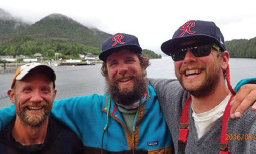 When we rang the bell and shotgunned the Rainiers we found beside it, it had been 23 days and 22 hours since we left Victoria. We finished one minute ahead of Paul with the hole in his leg; an ignominious distinction, but my old rowing coach told me “you never want to be on the wrong side of a photo finish.” Our mom Julia and my partner Alex were there at the dock, graciously ignoring our sweaty beards and crazy eyes and hugging us anyway. Between naps, stories and beers sloshed between the teams and supporters still in Ketchikan. Without the joy of reliving and relishing our experiences on the trip, I don’t think I could have handled having it be over. By the end, we were fully enjoying life on Bunny, completely bewitched by the Inside Passage. Parts of us wished we were continuing on the adventure, seeing what magic the coast held in store next. But having completed our dinghy journey from Bainbridge Island to Alaska, we realized it was probably best not to chance it.
When we rang the bell and shotgunned the Rainiers we found beside it, it had been 23 days and 22 hours since we left Victoria. We finished one minute ahead of Paul with the hole in his leg; an ignominious distinction, but my old rowing coach told me “you never want to be on the wrong side of a photo finish.” Our mom Julia and my partner Alex were there at the dock, graciously ignoring our sweaty beards and crazy eyes and hugging us anyway. Between naps, stories and beers sloshed between the teams and supporters still in Ketchikan. Without the joy of reliving and relishing our experiences on the trip, I don’t think I could have handled having it be over. By the end, we were fully enjoying life on Bunny, completely bewitched by the Inside Passage. Parts of us wished we were continuing on the adventure, seeing what magic the coast held in store next. But having completed our dinghy journey from Bainbridge Island to Alaska, we realized it was probably best not to chance it.
I was different after R2AK. Not just the deep tiredness and missing 15 pounds, but a sense of inner peace I’d never experienced. I lived R2AK’s subjective definition of success; despite being nearly the last finishers, we were treated like we had won. The boundaries of the world had been unzipped, unveiling entirely new territory. I longed to be back in the Inside Passage, and was determined to spend as much time in boats as possible. In my fellow racers, the race organizers, and our supporters, my community had just blossomed tenfold, an eclectic band hailing from all walks of life, united in shared dreams and experience.
From that first Blazer Party In 2015, I entered a period of irrevocable change, with yearly inflection points coming reliably at each ensuing Port Townsend Wooden Boat Festival. Three months after our race, Coop and I were asked to give a presentation about our trip at the 2016 Port Townsend Wooden Boat Festival (despite the conspicuous plastic-ness of our boat). I don’t know if it was the hangover from the previous night’s Blazer Party or just reliving the trip (probably both), but it was an emotional, powerful experience to share our adventure with a room full of friends, family, and enthusiastic strangers. Of course we thought our trip was cool, but we could barely wrap our heads around the outpouring of support. Our Bunny Whaler schtick had somehow gone from an inside joke to a story celebrated by boating legends whose names we’d known since we were kids.
Race to Alaska had not only been the adventure of a lifetime, but it had deepened my family ties, facilitated finding love, and given me a humbling new community – what more could it do? After our presentation, I met up with Steve Stone and Eric Blake, who had interviewed us before R2AK for their boating website, Off CenterHarbor.com (OHC). They were looking for someone with internet and film skills near Port Townsend, the closest thing on the West Coast to their own wooden boat-loving homeport of Brooklin, Maine. With my degree in Film Studies (like an English major, but with movies!) and some pre-coaching background in online marketing, it was an unbelievable fit and I jumped at the opportunity.
Fast forward another year to the 2017 Wooden Boat Festival. Out on the deck during the Blazer Party, Race Boss Daniel Evans wanted my opinion. “What do you think of a race, like a mini-R2AK, from Tacoma to Port Townsend, with a 48-hour time limit?” I loved it. That idea became R2AK’s angry little human-powered brother, Seventy48.
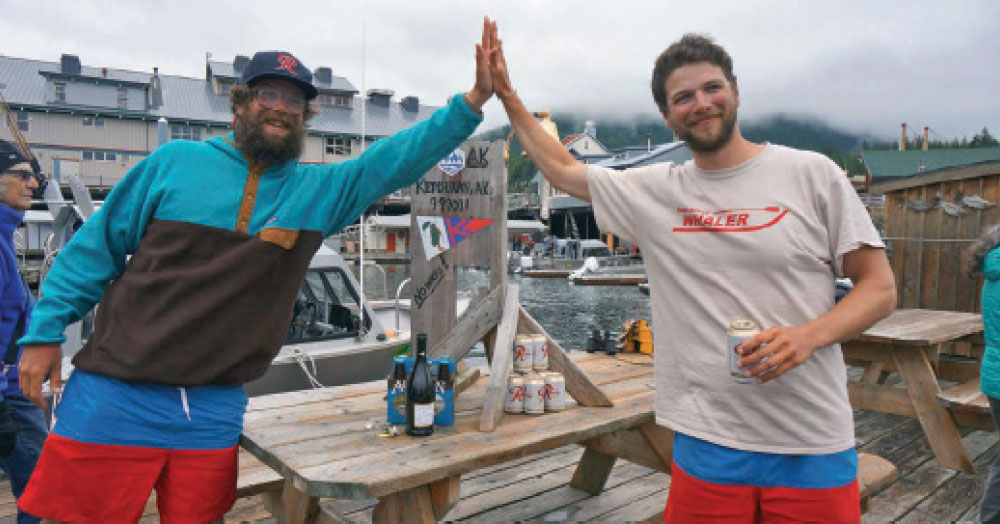 Two years out from Bunny’s epic journey, I was ready to plan for something new, appealingly without as much danger, time, or preparation required. I decided to build my own boat for Seventy48 – partly to return to the old dream of building a boat for the Inside Passage, partly to create a perfect long-distance human-powered watercraft. Clint Chase, a designer whose boats I knew and admired from my work with OHC, modified his Drake RaceBoat to better accommodate a sliding seat, extending it to 20 feet overall. Building a 20’ boat while living in Seattle was only possible thanks to the generosity of the amazing people at Seattle’s Center for Wooden Boats, who let me build it in their North Lake Shop. Along the way, boating legends like Russell Brown, Marty Loken, and David Bergey contributed immeasurable support, while my family and friends helped me push to get the boat done in time.
Two years out from Bunny’s epic journey, I was ready to plan for something new, appealingly without as much danger, time, or preparation required. I decided to build my own boat for Seventy48 – partly to return to the old dream of building a boat for the Inside Passage, partly to create a perfect long-distance human-powered watercraft. Clint Chase, a designer whose boats I knew and admired from my work with OHC, modified his Drake RaceBoat to better accommodate a sliding seat, extending it to 20 feet overall. Building a 20’ boat while living in Seattle was only possible thanks to the generosity of the amazing people at Seattle’s Center for Wooden Boats, who let me build it in their North Lake Shop. Along the way, boating legends like Russell Brown, Marty Loken, and David Bergey contributed immeasurable support, while my family and friends helped me push to get the boat done in time.
I launched my boat two weeks before the race and went on to finish in 14 hours, 9 minutes, good enough for third solo and 11th overall. Not since R2AK had I felt such satisfaction and gratitude for the support and kindness of so many people.
This summer, I will join Captain Coop and some friends from R2AK in delivering Maks to the Moon, the R2AK 2018-winning Melges 32 of Team Sail Like A Girl, back from Ketchikan after this year’s race. I don’t know how I’ve let three years go by without returning to the Inside Passage, but that’s long enough. I’m already dreaming of seeing the shores, seas, and whales. With a cabin and an outboard, we plan to stay safe, take our time, and stop to explore when and where we please. Best laid plans, eh?
After that, I don’t know what comes next. All I know is that when it does, I’ll have R2AK to thank for it.
Nate Rooks
Nate Rooks was raised on Bainbridge Island, WA, and now lives in Vancouver, BC. He’s Marketing Director and West Coast Video Producer for boating website Off CenterHarbor.com, where you can find videos about his R2AK and Seventy48 adventures.

